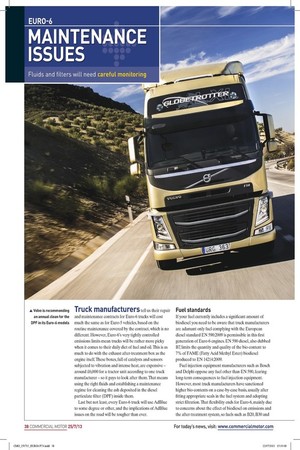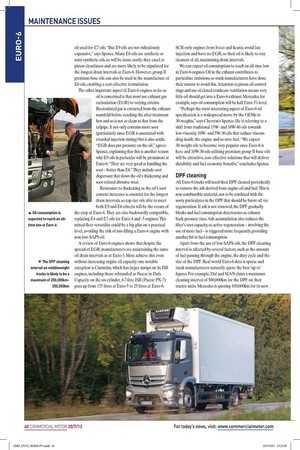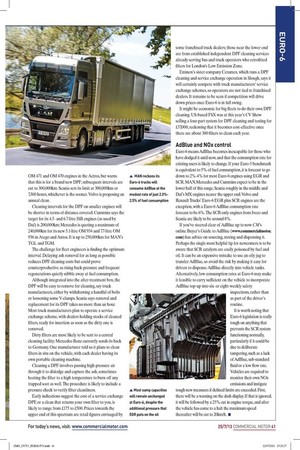EURO-6 MAINTENANCE Fluids and filters will need careful monitoring TLC
Page 32

Page 33

Page 34

Page 35

If you've noticed an error in this article please click here to report it so we can fix it.
for Euro-6 trucks In the fourth of our series running up to the arrival of Euro-6 trucks, we look at their vital fluids and DPF cleaning Words: David Wilcox Truck manufacturers tell us their repair and maintenance contracts for Euro-6 trucks will cost much the same as for Euro-5 vehicles, based on the routine maintenance covered by the contract, which is no different. However, Euro-6's very tightly controlled emissions limits mean trucks will be rather more picky when it comes to their daily diet of fuel and oil. This is as much to do with the exhaust after-treatment box as the engine itself. These boxes, full of catalysts and sensors subjected to vibration and intense heat, are expensive — around £6,000 for a tractor unit according to one truck manufacturer — so it pays to look after them. That means using the right fluids and establishing a maintenance regime for cleaning the ash deposited in the diesel particulate filter (DPF) inside them.
Last but not least, every Euro-6 truck will use AdBlue to some degree or other, and the implications of AdBlue issues on the road will be tougher than ever. Fuel standards If your fuel currently includes a significant amount of biodiesel you need to be aware that truck manufacturers are adamant only fuel complying with the European diesel standard EN 590:2009 is permissible in this first generation of Euro-6 engines. EN 590 diesel, also dubbed B7, limits the quantity and quality of the bio -contentto 7% of FAME (Fatty Acid Methyl Ester) biodiesel produced to EN 14214:2009.
Fuel injection equipment manufacturers such as Bosch and Delphi oppose any fuel other than EN 590, fearing long-term consequences to fuel injection equipment. However, most truck manufacturers have sanctioned higher bio-contents on a case-by-case basis, usually after fitting appropriate seals in the fuel system and adopting strict filtration:Mat flexibility ends for Euro-6, mainly due to concerns about the effect of biodiesel on emissions and the after-treatment system, so fuels such as B20, B30 and B100 will be off-limits.
Tests show that biodiesel increases the amount of NOx generated during combustion. Daimler identified a 33% hike in NOx when using B100 in its 12.8-litre 0M471 engine. Euro-6's NOx limit is so tight that this is unwelcome. And tests have shown that engines run on B100 deposit 50% more ash in their DPF than those running on EN 590 diesel. This shortens the DPF cleaning interval, raising maintenance costs.
None of these issues would have an immediate catastrophic effect on an engine, but it is clear they are best avoided.
Even though EN 590 diesel is compulsory for the first Euro-6 engines, this does not necessarily spell the end of the road for high bio-content fuel. Technical solutions that address and manage these risks are sure to emerge, with Scania for one indicating that it plans to cater for even B100 in the foreseeable future. Alternatively, truck manufacturers may choose to accommodate individual customers by making a 'commercial decision' and adjusting contract hire prices to cover the risks and maintenance implications of high biodiesel blends.
Oil issues All Euro-6 trucks have diesel particulate filters in their exhaust after-treatment boxes. These are 'wall-flow' filters that force the exhaust gas through the filter substrate's porous walls, trapping even the smallest sooty particulates and ash. This ash is principally the burnt remnants of metallic additives in the tiny amount of engine oil that gets past piston rings into the exhaust stream. This is why low-SAPS (sulphated ash, phosphorus and sulphur) engine oils are specified for engines with DPFs. These oils produce less ash, so the DPF needs cleaning less often. Their low sulphur and phosphorus content is also kinder to catalysts.
This has implications if you currently use one of the popular E7 mineral oils or a more expensive semior fully-synthetic E4: neither is right for Euro-6. Truck manufacturers will instead insist on E6 and E9 oils, the only low-SAPS oils in the oil specifications drawn by the European vehicle manufacturers' organisation, ACEA (Association des Constructeurs Europeens dAutomobiles). Where truck manufacturers quote their own oil specifications, these too are low-SAPS for Euro-6, such as Mercedes' MB 228.51 (similar to an E6) or Volvo's VDS-4 (similar to an E9).
David Spence, channel marketing manager for Chevron Lubricants, the company behind Texaco Ursa oils, explains that, although still mineral-based, E9 oils can deliver low-SAPS performance because they are made from low-sulphur (group II) base oil which goes through additional processing when compared to the group I base oil used for E7 oils. "But E9 oils are not ridiculously expensive," says Spence. Many E6 oils are synthetic or semi-synthetic oils, so will be more costly; they excel at piston cleanliness and are more likely to be stipulated for the longest drain intervals at Euro-6. However, group II premium base oils can also be used in the manufacture of E6 oils, enabling a cost-effective formulation.
The other important aspect of Euro-6 engines so far as oil is concerned is that most use exhaust gas recirculation (EGR) to varying extents. Recirculated gas is extracted from the exhaust manifold before reaching the after-treatment box and so is not as clean as that from the tailpipe. It not only contains more soot (particularly since EGR is associated with retarded injection timing) but is also acidic. "EGR does put pressure on the oil," agrees Spence, explaining that this is another reason why E9 oils in particular will be prominent at Euro-6. "They are very good at handling the soot — better than E6." They include soot dispersant that slows the oil's thickening and soot-related abrasive wear.
Resistance to thickening as the oil's soot content increases is essential for the longest drain intervals, so top-tier oils able to meet both E9 and E6 criteria will be the cream of the crop at Euro-6. They are also backwardly compatible, replacing E4 and E7 oils for Euro-4 and -5 engines. This mixed-fleet versatility could be a big plus on a practical level, avoiding the risk of mis-filling a Euro-6 engine with non-low-SAPS oil.
A review of Euro-6 engines shows that despite the spread of EGR, manufacturers are maintaining the same oil drain intervals as at Euro-5. Most achieve this even without increasing engine oil capacity: one notable exception is Cummins, which has larger sumps on its ISB engines, including those rebranded as Paccar in Dafs. Capacity on the six-cylinder, 6.7-litre ISB (Paccar PX-7) goes up from 17.5 litres at Euro-5 to 25 litres at Euro-6. SCR-only engines from Iveco and Scania avoid late injection and have no EGR, so their oil is likely to stay cleanest of all, maximising drain intervals.
We can expect oil consumption to reach an all-time low in Euro-6 engines. Oil in the exhaust contributes to particulate emissions, so truck manufacturers have done their utmost to avoid this. Attention to piston oil-control rings and use of closed crankcase ventilation means very little oil should get into a Euro-6 exhaust. Mercedes, for example, says oil consumption will be half Euro-5's level.
"Perhaps the most interesting aspect of Euro-6 oil specification is a widespread move by the OEMs to 30-weights," says Chevron's Spence. He is referring to a shift from traditional 15Wand 10W-40 oils towards low-viscosity 10Wand 5W-30 oils that reduce viscous drag inside the engine and so save fuel. "We expect 30-weight oils to become very popular once Euro-6 is here and 10W-30 oils utilising premium group II base oils will be attractive, cost-effective solutions that will deliver durability and fuel economy benefits," concludes Spence.
DPF cleaning All Euro-6 trucks will need their DPF cleaned periodically to remove the ash derived from engine oil and fuel. This is non-combustible material, not to be confused with the sooty particulates in the DPF that should be burnt off via regeneration. If ash is not removed, the DPF gradually blocks and fuel consumption deteriorates as exhaust back-pressure rises. Ash accumulation also reduces the filter's soot capacity, so active regeneration — involving the use of more fuel — is triggered more frequently, providing another hit to fuel consumption.
Apart from the use of low-SAPS oils, the DPF cleaning interval is affected by several factors, such as the amount of fuel passing through the engine, the duty cycle and the size of the DPF. Real-world Euro-6 data is sparse and truck manufacturers naturally quote the best 'up to' figures. For example, Daf and MAN claim a maximum cleaning interval of 500,000km for the DPF on their tractor units. Mercedes is quoting 450,000km for its new OM 471 and OM 470 engines in the Actros, but warns that this is for a brand new DPF; subsequent intervals are cut to 300,000km. Scania sets its limit at 300,000km or 7,300 hours, whichever is the sooner. Volvo is proposing an annual clean.
Cleaning intervals for the DPF on smaller engines will be shorter in terms of distance covered. Cummins says the target for its 4.5and 6.7-litre ISB engines (as used by Daf) is 200,000km; Mercedes is quoting a maximum of 240,000km for its new 5.1-litre OM 934 and 7.7-litre OM 936 in Atego and Antos. It is up to 250,000km for MAN's TGL and TGM.
The challenge for fleet engineers is finding the optimum interval. Delaying ash removal for as long as possible reduces DPF cleaning costs but could prove counterproductive as rising back-pressure and frequent regenerations quietly nibble away at fuel consumption.
Although integrated into the after-treatment box, the DPF will be easy to remove for cleaning, say truck manufacturers, either by withdrawing a handful of bolts or loosening some V-clamps. Scania says removal and replacement for its DPF takes no more than an hour. Most truck manufacturers plan to operate a service exchange scheme, with dealers holding stocks of cleaned filters, ready for insertion as soon as the dirty one is removed.
Dirty filters are most likely to be sent to a central cleaning facility: Mercedes-Benz currently sends its back to Germany. One manufacturer told us it plans to clean filters in situ on the vehicle, with each dealer having its own portable cleaning machine.
Cleaning a DPF involves passing high-pressure air through it to dislodge and capture the ash, sometimes heating the filter to a high temperature to burn off any trapped soot as well. The procedure is likely to include a pressure check to verify filter cleanliness Early indications suggest the cost of a service exchange DPF, or a clean that returns your own filter to you, is likely to range from £175 to £500. Prices towards the upper end of this spectrum are retail figures envisaged by some franchised truck dealers; those near the lower end are from established independent DPF cleaning services already serving bus and truck operators who retrofitted filters for London's Low Emission Zone.
Eminox's sister company Ceramex, which runs a DPF cleaning and service exchange operation in Slough, says it will certainly compete with truck manufacturers' service exchange schemes, so operators are not tied to franchised dealers. It remains to be seen if competition will drive down prices once Euro-6 is in full swing.
It might be economic for big fleets to do their own DPF cleaning. US-based FSX was at this year's CV Show selling a four-part system for DPF cleaning and testing for £37,000, reckoning that it becomes cost-effective once there are about 300 filters to clean each year.
AdBlue and NOx control Euro-6 means AdBlue becomes inescapable for those who have dodged it until now, and that the consumption rate for existing users is likely to change. If your Euro-5 benchmark is equivalent to 5% of fuel consumption, it is forecast to go down to 2%-4% for most Euro-6 engines using EGR and SCR. MAN, Mercedes and Cummins expect to be in the lower half of this range, Scania roughly in the middle and Daf's MX engines nearer the upper end. Volvo and Renault Trucks' Euro-6 EGR plus SCR engines are the exception, with a Euro-6 AdBlue consumption rate forecast to be 6%. The SCR-only engines from Iveco and Scania are likely to be around 8%.
If you've steered clear of AdBlue up to now CM's online Buyer's Guide to AdBlue (www.commercialmotor. corn) has advice on sourcing, storing and dispensing it. Perhaps the single most helpful tip for newcomers is to be aware that SCR catalysts are easily poisoned by fuel and oil. It can be an expensive mistake to use an oily jug to transfer AdBlue, so avoid the risk by making it easy for drivers to dispense AdBlue directly into vehicle tanks. Alternatively, low consumption rates at Euro-6 may make it feasible to carry sufficient on the vehicle to incorporate AdBlue top-up into sixor eight-weekly safety inspections, rather than as part of the driver's routine.










































